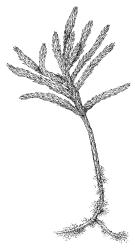A family of two genera, with Climacium the more widespread and better known. Crum & Anderson (1981, p. 1227) defined the family by having dendroid branching of secondary stems arising from a subterranean "rhizome", an abundance of filiform paraphyllia, ± ovate leaves with a single strong costa ending below the leaf apex, dioicous sexuality, and erect capsules with essentially hypnoid peristomes. Goffinet et al. (2009) place the Climaciaceae in the Hypnales.
Pleuroziopsis, a monotypic genus confined to the northern Pacific Rim, was segregated from the Climaciaceae by Ireland (1968); Goffinet et al. (2009) did not accept the segregate Pleuroziopsidaceae, and circumscribed the Climaciaceae in the same manner as did Brotherus (1925). No separate family description is provided here. Pleuroziopsis differs from Climacium mainly by having curved, more or less horizontal capsules and by peristome differences.
| Category | Number |
|---|---|
| Exotic: Fully Naturalised | 1 |
| Total | 1 |




